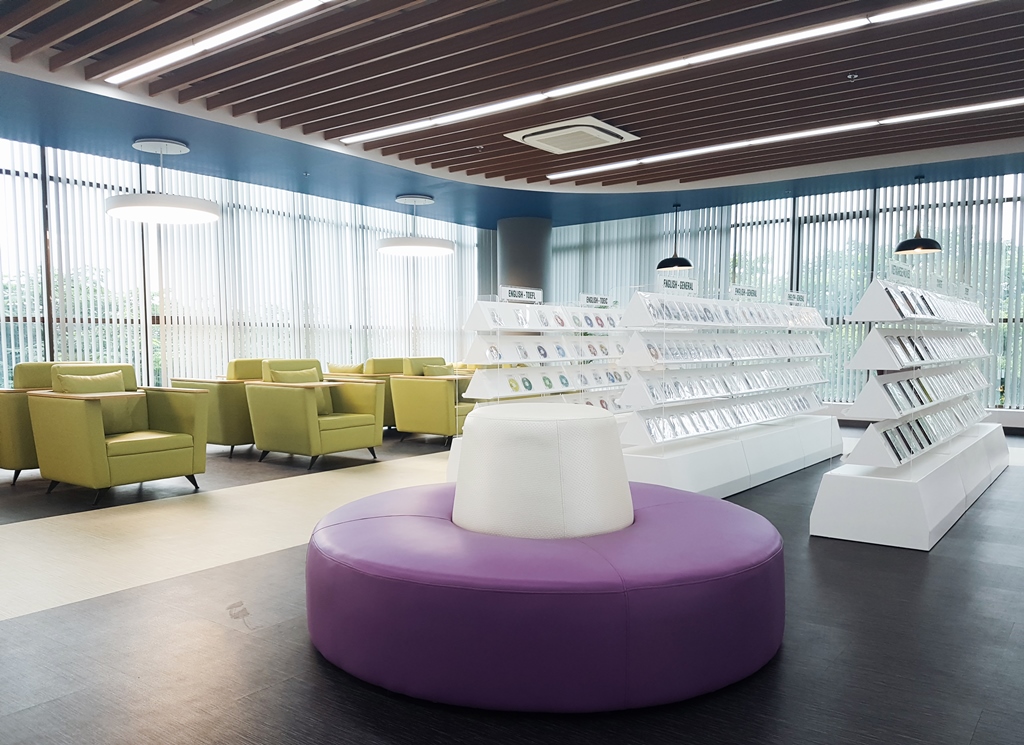Imagine yourself as a student or a visitor exploring Ton Duc Thang University's (TDTU) Library – a name recently praised and admired by the public. Upon visiting, one can clearly see that this library is a perfect example of how interior design plays a crucial role in creating an innovative space.
While architecture emphasizes visual impressions in design, interior design focuses on ensuring comfort in using that space. Anyone who has visited TDTU's library campus can attest to this. With its 7 floors designed in a modern style, the harmonious space and interior have left many first-time visitors stunned, affirming that this library is truly unparalleled in Vietnam today.

The vibrant yellow and white tables stand out, enhancing the scholarly ambiance and stimulating creativity for those stepping into the library.
Few know that the creatively designed library space, with its unique furniture pieces, refined color schemes, and modern aesthetic, is the result of a long-term, meticulous, and challenging collaboration between the HOME’FURNI brand, known for entertainment areas and coffee corners, and O’FURNI office furniture, providing seating for reading areas, meeting rooms, and Ton Duc Thang University. It all began with numerous difficulties and challenges.

And up to this point, it can be said that talented interior designers have infused the building's structure, giving each floor a unique and impressive theme with its own distinctive color scheme.
The first challenge began with the library's name: TDTU INSPiRE Library – The Library of Inspiration! Therefore, if someone steps in and doesn't feel inspired or grasp the library's spirit, it would be considered a failure. Faced with this pressure, the creative design and furniture supply team continuously collaborated closely with the faculty and students of Ton Duc Thang University to harmonize every detail of the interior—from materials, dimensions, to colors of each component—aligning perfectly with the library's design concept.

Floor 2 is named Nỗ lực (Nisus).

Floor 3 is named Minh mẫn (Sagacity).
Looking at the spacious, bright, and harmonious environment, one immediately senses its youthful, dynamic, and comfortable atmosphere. The minimalist and elegant bookshelf system, coupled with a rich variety of styles, colors, seating arrangements, discussion tables, lighting systems, screens, and decorative quotes scattered across the walls, create a library space that is intimate, cohesive, and warm.

Floor 4 is named Tiến bộ (Progress).
Throughout the 7 floors, the interior style reflects modernity with bright colors, complementing the predominant white tones of the library space, each floor distinguished by its own unique color palette. This sophisticated and harmonious interior design has infused a traditional academic environment, typically dry, with a fresh breath of inspiration and creativity.
Within this library, one can find charming seating areas, comfortable lounge chairs, cozy discussion corners, serene and comfortable deep study areas... Each space caters to different preferences: study areas, discussion spaces, meeting areas, a coffee corner, leisure reading areas, and exhibition halls.

The sensitive, refined, and harmonious interior style down to every detail has breathed life into the library space, igniting students' passion for learning.
The interior design experts have been exceptionally sensitive in capturing modern interior trends while considering the users' preferences, transforming what was once a dry library space into an inspiring and vibrant environment, almost poetic in essence, where every corner becomes a virtual hotspot for students.
The inspirational interior space harmoniously blends with the dynamic flow of creative knowledge, leaving a lasting impression on visitors to Vietnam's most advanced modern library. Undoubtedly, more inspirational libraries will be built in the future to nurture intellectual passion and provide a world-class learning environment right here in Vietnam.
Đinh Hằng – TCKT.VN
© Tạp chí kiến trúc - Architecture Magazine"



